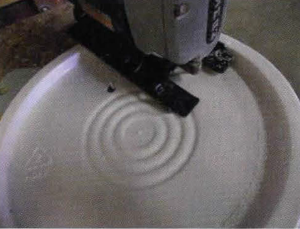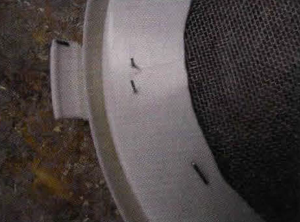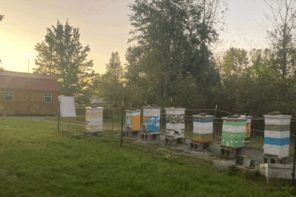By: Ed Simon
This article originally appeared in the Summer 2016 issue of BEEKeeping Your First Three Years
We all have been caught short when we have had more swarm calls than we had hives to put them. But before we can put them in a hive, we have to get them into a container and get them back to the bee yard. Cardboard boxes work great except they are either too large or too small and they require a quickly added screened opening or small holes to be added so the bees won’t overheat. Bee vacuums work. But sometimes they are overkill for the location and size of the swarm.
Let the good old five gallon utility pail come to the rescue. Cheap (usually free), adequate size and almost indestructible, the plastic pail is an indispensable around our workshop and barn. So why not use it to collect the next swarm.
Parts
• Plastic bucket with a lid – 5 gallon size works great
• 8 mesh hardware cloth – 1/8″ holes
• Epoxy or pop rivets and/or silicone sealant
Construction
Step 1: Remove lid seal
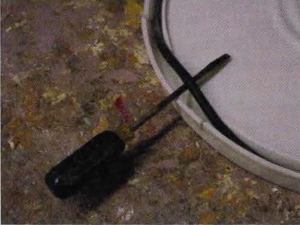 A rubber gasket is almost always located under the locking rim of the bucket lid. Use a screw driver to pry the gasket out.
A rubber gasket is almost always located under the locking rim of the bucket lid. Use a screw driver to pry the gasket out.
There is no need to keep the rim hermetically sealed in when you are going to put a big screened hole in the top. The gaskets also seem to get in the way at the most inconvenient time.
Drill a starting hole in the lid, and then use your scroll saw to cut a bigger hole in the top. Make this hole as large as possible and still leave room to attach the screen. I use the outside rim of the lid to guide the saw. It makes for a nice neat hole.
Step 3: Remove some lid locking tabs
Note: Remove the locking tabs a few at a time. You want the lid to be easy to remove and at the same time be firmly attached when set in place.
Decision time: most buckets have locking tabs that make it very difficult to remove the lid. What you don’t need is to be fumbling around with the lid while the bees inside are getting madder and madder. The best way to make the lid removal easier is to cut most of the tabs off while leaving a sealing ridge to keep the bees in. The buckets I’ve been using have eight distinct locking tabs. I completely remove every other one. This leaves four locking tabs. One at each corner. (Did you know that circles have corners?)
Then I also cut all but 1 1/2″ off of the remaining tabs. This makes for a very easily removable lid that will still stay locked in place when closed.
Use some sandpaper or a utility knife to clean up the ragged edges on the cuts you made. Now isn’t it pretty!
Step 5: Fit hardware cloth
Use the lid as a pattern and cut the hardware cloth to fit inside the top ridge.
Step 6: Staple cloth over hole
Staple the cloth to the lid. Use long enough staples to allow you to crimp the staple on the reverse side of the lid. A ½” staple works great. You can staple the lid into your work – bench or a piece of soft wood and then pry it off with a screwdriver.
Step 7: Crimp the staples
Turn the lid over and crimp the staples so they will hold the screen in place.
The funnel you’re about to make acts as a one way opening. It makes use of the bee’s inability to recognize a small opening that is not on a flat surface as an exit. The same concept (cone entrances) is used in many bee related devices such as pollen traps and escape boards.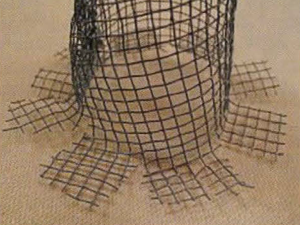
Step 8: Once the lid is complete, create a funnel from the hardware cloth (part 2). Make the funnel about seven inches long and taper it from a two inch opening to a half inch opening on the other end. Epoxy or pop rivet the hardware cloth into the funnel shape.
Step 9: After the funnel is complete, use a pair of tin snips to put a flange on the large end of the funnel. Then using the top of the cone (the inside edge of the flange) as a guide cut a hole in the center of the top you made in Step 2. Slip the funnel into the hole and use epoxy or silicone glue to hold it in place.
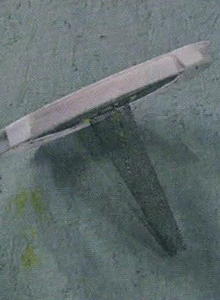 Step 10: Allow the epoxy or the silicone sealant to dry and you have a very useful piece of equipment.
Step 10: Allow the epoxy or the silicone sealant to dry and you have a very useful piece of equipment.
Usage
After initially getting the swarm into the swarm bucket, put this top on the bucket. Then set the bucket near where the swarm was originally caught and wait. Assuming you caught the queen,
eventually all the bees in the swarm will try to get close to her. They’ll walk down through the large end of the funnel and be unable to exit the bucket.
Thoughts
In addition to having a simple swarm collection bucket that is always ready, you can use it to carry equipment when the need arises. Have more than one swarm bucket handy. In the past three years I have come to rely on this device for most of the swarms I have caught. Twice during the peak swarming season. I have been called out on a second swarm retrieval before I was able to hive the first swarm. On a third occasion the swarm was so big and difficult to get that I missed the queen on the first try. The bees immediately started to return to the original swarm location. I put the lid on this first bucket and used a second bucket to get the queen and the remainder of the swarm. 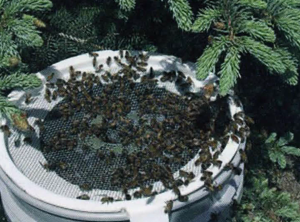
This device is cheap, easy to make and works fantastically.
That’s all folks, Happy Hunting.







